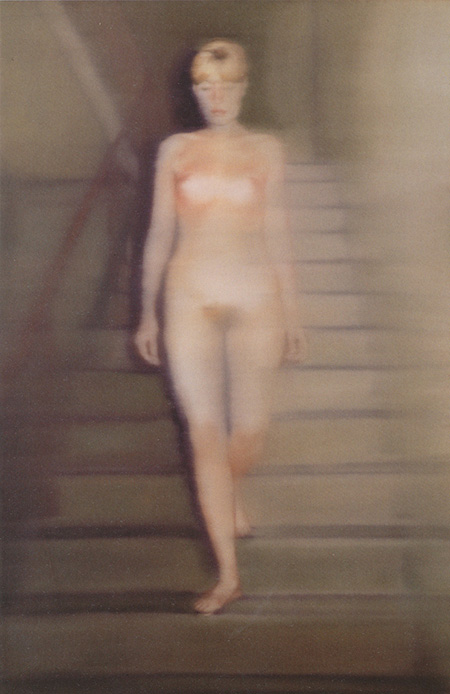
In a recent column, I discussed a number of films about art and artists that I thought worth your while. Naturally, I forgot or missed some. Recently I saw Maurice Pialat's 1991 film, "Van Gogh," with Jacques Dutronc in a mesmerizing performance as the artist: quiet and observant. — internalized — and very different from Kirk Douglas' energetic interpretation in "Lust for Life" (which Dutronc said in an later interview that he liked, as do I). Pialat's is a naturalistic film, verging on cinema verité, unbound by Hollywood script mechanics. It's also a wonderful recreation of an 1880s rural France that might have sprung from a Renoir or Lautrec painting. It refuses to hit the usual hagiographic high notes of Van Gogh's wounding or death, which take place offscreen, but is no less affecting for that reticence.
Less reticent is Florian Henckel von Donnersmarck's new film (only his third), "Never Look Away," a fiction that is loosely based on the life of Gerhard Richter, who has intriguingly disavowed the film. The story of a young artist's development in Nazi Germany in the1940s, then in Communist East Germany in the 1950s, and finally in free West Germany in the 1960s sounds, with its interweaving of biography, history and politics, almost too good to be true. And so it is, though only slightly; I recommend it. The three-hour-long film's recreation of the past is faultless, and Caleb Deschanel's photography is gorgeous; in those respects "Never Look Away" is similar to Mike Leigh's "Mr. Turner" (2014), another mixed success that is sumptuous, but suffering from a flawed script.
Von Donnersmarck's first film, "The Lives of Others" (2007), was an astonishing début, comparable to Orson Welles' 1941 "Citizen Kane," and one of the best movies I have ever seen for its integration of art and politics. In it, a leftist playwright, played by Sebastian Koch, in Communist East Germany, is suspected of subversion by a dedicated Stasi agent, played by the late Ulrich Mühe, who spies upon him — and is gradually converted from rigid conformity to a humanist appreciation for beauty and ambiguity. Sitting hour after hour, listening through headphones, he's transformed. We feel humanized as well, in the course of watching him. When he helps save the playwright from prison, he is discovered and demoted. Ten years later, the playwright, having discovered the facts, dedicates a memoir to his benefactor, who is now sweeping streets. The disgraced Stasi agent sees it in a bookstore window. Fade out. That's an ending worthy of the best Charles Chaplin: sentimental, moving and profoundly human.
Unfortunately, "Never Look Away," for all its plot contrivances, political melodrama and comedy, does not soar into filmic immortality in the same way. Kurt, the young protagonist is a born observer, but powerless and seemingly unaffected when his young 'artistic' aunt, given to spells of madness, is seized by the Nazis for sterilization and extermination. Members of his family perish in the war, after which Kurt tells his father, a former teacher reduced after denazification to scrubbing floors, that everything is connected (echoing his aunt's delusion) and that he need never worry. Later, Kurt discovers that his father has hanged himself, a plot detail borrowed from Philip Guston's life in which the ten-year-old discovered his father's body [If Richter's father ultimately did commit suicide, we have not been able to verify it; but Guston and Kurt were far younger than would have been the case for an older Gerhard--Ed.]. Kurt enters art school in East Berlin and soon becomes a star pupil, charged with creating an important Socialist Realist mural due to his professor's efforts. Kurt betrays him when he flees to West Berlin, shortly before the wall is completed, with his young wife, who has, shall we say, some issues with her gynecologist father (Sebastian Koch, the protagonist in "The Lives of Others"), a former Nazi who has managed to stay undiscovered. We see the mural (it's not that great, even for Socialist Realism: a bit too lumpish for officialdom, frankly) being whitewashed after the defection, and we're supposed to feel — what? Genius is too good for this wicked world?
Given this richly tragic story, we might expect a fittingly triumphant ending, but alas, no. Kurt, faced by the artistic liberties of the west as embodied in the Joseph Beuys figure at Dusseldorf Academy, is reduced to creative paralysis, experimenting with meaningless avant-garde trickery (walking on and slashing canvases, which, according to his teacher, are "not you") before finally sitting immobile at his easel for entire days. Salvation comes when he seizes upon old photos of himself with his doomed aunt in happier times; and of his odious Aryan father-in-law. He grids the photographs and paints them in grisaille, then takes a dry flat brush and smears horizontal streaks across them, simulating the depredations of time and history. When a rich classmate exhibits the work, they are a sensation, and at the end, at the Wuppertal Kunsthalle, Kurt answers questions from the arty audience about his imagery — and lies: they're nobody in particular, he says; it's easier when I don't know the people. As for doing more gray snapshots: no, I am interested in color charts now. It's an oddly antiheroic, banal conclusion. No matter that it follows Richter's career, it trivializes it. There are, however, metaphoric choruses of bus horns, resoundingly linking the 1940s and the 1960s.
The recreation of the 1937 Degenerate Art show in Berlin, for which duplicates of lost paintings were made, is a highlight. As for including a Monkees-style montage of art-student hijinks, set to Francoise Hardy's "Le Temps de L'Amour," well, it was the Sixties, everywhere. And everything was connected.
